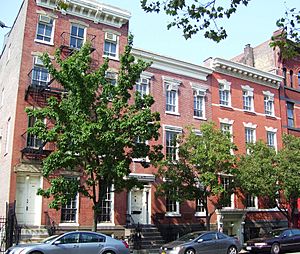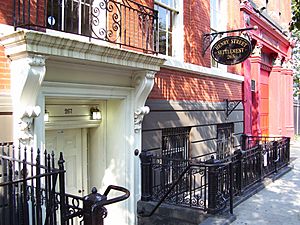Henry Street Settlement facts for kids
|
Henry Street Settlement
and Neighborhood Playhouse |
|

(2011)
|
|
| Location | 263–267 Henry St., and 466 Grand Street Manhattan, New York, U.S. |
|---|---|
| Area | 1 acre (0.40 ha) |
| Built | 1827 |
| Architect | 267: Buchman & Fox |
| Architectural style | Federal, Greek Revival, Colonial Revival |
| NRHP reference No. | 74001272 |
Quick facts for kids Significant dates |
|
| Added to NRHP | September 13, 1974 |
| Designated NHL | May 30, 1974 (263, 265, and 267 Henry Street and 466 Grand Street) February 11, 2022 (redesignation of 265 and 267 Henry Street) |
The Henry Street Settlement is a special organization in New York City that helps people of all ages. It is located on the Lower East Side of Manhattan. This group offers social services, arts programs, and health care to people living in New York. It was started in 1893 by a nurse and reformer named Lillian Wald. At first, it was called the Nurses' Settlement.
Contents
What the Settlement Does
The Henry Street Settlement helps about 50,000 people every year. They support many different groups of people. This includes families with lower incomes and young people from ages 2 to 21. They also help older adults and people facing health challenges. Many people also enjoy the arts programs, classes, and shows at the Abrons Arts Center.
The main offices are still in the original buildings at 263, 265, and 267 Henry Street. These buildings are old row houses built around 1832. The Settlement offers its services at 17 different locations. Many of these are in buildings run by the New York City Housing Authority.
The buildings at 263, 265, and 267 Henry Street became important New York City designated landmarks in 1966. These buildings, along with the Neighborhood Playhouse at 466 Grand Street, were added to the National Register of Historic Places in 1974. They were also named a National Historic Landmark in 1989. The buildings at 265 and 267 Henry Street were again recognized in 2022 as the Lillian Wald House.
How the Settlement Started
In 1892, Lillian Wald was a 25-year-old nurse. She was studying to be a doctor. She volunteered to teach a class about home health care. This class was for immigrant women on the Lower East Side. One day, a young girl came to her, saying "mommy ... baby ... blood." Lillian Wald followed the girl to her home. It was a small, crowded apartment. Inside, she found the girl's mother who had just given birth and needed medical help. The doctor had left because the family could not pay him.
This was Lillian Wald's first time seeing such poverty. She said it was her "baptism by fire." This experience made her want to help people. She decided to bring nursing care, education, and arts to the poor immigrant families. The next year, she started the Nurses' Settlement. Later, it became known as the Henry Street Settlement.
Two years later, in 1895, a banker named Jacob Schiff bought a house for the new organization. It was a Federal style townhouse at 265 Henry Street. The building was made taller to create more space. Schiff gave the building to the Settlement in 1903. In 1902, the Settlement added new places, including a gym.
The organization grew even more in 1906. Morris Loeb bought the building at 267 Henry Street for them. This Greek Revival townhouse had been updated in 1900.
In 1915, the Neighborhood Playhouse was created. It was one of the first "Little Theatres." Sisters Alice and Irene Lewisohn started it. They wanted to offer classic plays to the people in the area. The theater is still open today and is called the Harry De Jur Playhouse.
In 1927, the Henry Street Music School opened. Famous musicians like Aaron Copland supported it. In 1937, the school put on a special play-opera called The Second Hurricane. It had music by Copland and was directed by Orson Welles. Many talented students have attended the music school.
The Settlement started using the townhouse at 263 Henry Street in 1938. They used it for classrooms and homes. In 1949, they bought the building. This brought together three townhouses: 263, 265, and 267. This helped save a part of the old street from the 1820s. This block of Henry Street still looks like uptown Manhattan did almost 200 years ago.
Henry Street is known for its new ideas in helping people and providing health care. Some of their important firsts include:
- Opening one of New York City's first playgrounds in 1902.
- Paying for the first public school nurse in 1902.
- Starting the Visiting Nurse Service, which became its own group in 1944.
- Opening one of the country's first mental health clinics in 1946.
- Creating one of the first temporary homes for people without housing in 1972.
- Starting the first program for older adults in public housing in 1994.
- Opening the city's first safe shelter for women without homes in 2007.
In 2018, a secretary named Sylvia Bloom gave $6.24 million to the Settlement. This money helps students prepare for and finish college.
To celebrate Henry Street's 125th birthday, artist KAWS worked with them. He held a workshop for art students from the Lower East Side.
When actor and comedian Jerry Stiller passed away, he left money to the Settlement's Abrons Arts Center and Boys & Girls Republic. These programs help young people with their education and art skills.
In 2021, the Henry Street Settlement's main buildings were recognized as an important historic site. This was because of Lillian Wald's strong friendships and support network with other women who helped her run the settlement house.
Services Offered
The Henry Street Settlement offers many helpful services:
- Housing – They run four shelters for people without homes. One shelter is for families needing a safe place. They also provide long-term housing for people who used to be homeless and need support.
- Programs for Older Adults – These include a community for older adults, a senior center, and a program where volunteers visit older people. They also deliver meals to homes.
- Youth Programs – They have day care centers, after-school programs, and help for students getting ready for college. They also offer job programs for young people, classes to get a high school diploma, sports, and summer camps.
- Job Training – Their Workforce Development Center helps people find jobs and get training.
- Health and Wellness – They have clinics for mental and primary health care. They offer counseling, family services, and home care services.
- Community Help – The Neighborhood Resource Center helps people find out about benefits, get legal advice, and find affordable health insurance.
- Abrons Arts Center – Located at 466 Grand Street, this center offers art classes. You can learn dance, music, visual arts, and theater. They have shows in three theaters, including the historic playhouse. They also have art exhibits and summer camps.
Books About the Settlement
- The House on Henry Street by Lillian Wald
- The House on Henry Street: The Enduring Life of a Lower East Side Settlement, by Ellen Snyder-Grenier
See also
 In Spanish: Henry Street Settlement para niños
In Spanish: Henry Street Settlement para niños




